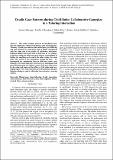School of Technology: Recent submissions
Now showing items 21-38 of 38
-
An Empirical Approach to Mobile Learning on Mobile Ad Hoc Networks
(IEEE, 2020)Mobile Ad hoc Networks (MANETs) are made up of mobile nodes that are interconnected wirelessly, while topology changes as mobile nodes join and leave the network. MANETs do not depend on fixed infrastructure. Due to ... -
3-Category Pedagogical Framework for Context Based Ambient Learning
(IEEE, 2013)Mobile phones have taken centre stage in transforming people’s lives in all sectors of African economies. With regard to Education sector, studies show that, there is high prevalence of mobile phones among learners in ... -
Open mobile ambient learning(OMAL): The next generation of mobile learning for 'mobile-rich' but 'computer-poor' contexts.
(Research Gate, 2014)By the end of year 2011, Africa had over 620 million mobile connections, overtaking Latin America to become second largest mobile market after Asia. According to Ilona Buchem in 2012, since mobile devices and applications ... -
Dynamic Heuristics: Greedy Search: A Mobile Information Retrieval Algorithm for Ambient Learning Systems
(Research Gate, 2016)Research supervision services like providing study materials can be enhanced through mobile information retrieval algorithms. An example is semantic searching algorithms, which require the user to input one or two real ... -
Ambient Learning - Knowledge as a Service Model: Towards the Achievement of Sustainable Development Goal Four
(IEEE, 2018)Studies show that United Nations Sustainable Development Goal Four is yet to be achieved. This paper presents an artefact named “Ambient learning- Knowledge as a Service model” for describing how actionable knowledge can ... -
Evaluation Model for Improving Ambient Learning Systems Towards Achieving Sustainable Development Goal Four
(IEEE, 2018)Among the 17 sustainable development goals specified by United Nations organization in 2015, goal four is the key for progress towards the achievement of all the other goals. However, studies show that this goal is yet ... -
Culture Aware M-Learning Classification Framework for African Countries
(Research Gate, 2014)African countries are currently experiencing proliferation of mobile phone subscriptions but no prevalence of personal computers or electricity (Parker, 2011). It is estimated that, by the end of 2015 in Sub-Saharan Africa, ... -
Ambient Learning Conceptual Framework for Bridging Digital Divide in Higher Education
(Research Gate, 2014)According to ITU (2012), digital divide is the difference between countries in terms of levels of ICT development. This difference remains significant. In 2011, the ICT Development Index (IDI) value of developed countries ... -
A Knowledge-as-a-Service Support Framework for Ambient Learning in Kenya
(, 2020)Knowledge as a Service (KaaS) is a relatively new model, albeit one that is rapidly gaining popularity within cloud computing environments. Over the recent years, learners have experienced a constant need to access on ... -
Directing Attention Through Gaze Hints Improves Task Solving in Human-Humanoid Interaction
(International journal of social robotics, 2018-04-06)In this paper, we report an experimental study designed to examine how participants perceive and interpret social hints from gaze exhibited by either a robot or a human tutor when carrying out a matching task. The underlying ... -
Gaze-based interaction for effective tutoring with social robots
(Technische Universiteit Eindhoven, 2020-10-28)The central thesis of this work is that effective gaze behavior can help build a shared understanding and mutual awareness between humans and robots, leading to positive outcomes in a tutoring interaction. Gaze behavior ... -
Dyadic Gaze Patterns during Child-Robot Collaborative Gameplay in a Tutoring Interaction
(IEEE, 2018)This study examines patterns of coordinated gaze between a child and a robot (NAO) during a card matching game, ‘Memory’. Dyadic gaze behavior like mutual gaze, gaze following and joint attention are indications both of ... -
Modeling Spatial Interactions between Areas to Assess the Burglary Risk
(International Journal of Geo-Information, 2016-04)It is generally acknowledged that the urban environment presents different types of risk factors, but how the structural effects of areas influence the risk levels in neighboring areas has been less widely investigated. ... -
Contextual Factors And Public Value Of E-government Services In Kenya
(Global Scientific Journal, 2017-09-09)E-government research has been skewed towards technological deterministic perspective mainly centering on technological issues. This provides no explicit guidance to the design and practice of e-government programs that ... -
Environmental Risk Factors influencing Bicycle Theft: A Spatial Analysis in London, UK
(PLoS ONE, 2016)Urban authorities are continuously drawing up policies to promote cycling among commuters. However, these initiatives are counterproductive for the targeted objectives because they increase opportunities for bicycle ... -
Supporting E-Learning in Computer-poor Environments by Combining OER, Cloud Services and Mobile Learning
(Research Gate, 2014-12)Research supervision is an important type of support for advanced students when engaged in study projects or in writing their final theses. One of the most common complaints from research students is erratic or infrequent ... -
Dynamics of Technology Transfer for Innovation Processes in a Constrained Resource Settings: The Promise of Data Analytics and Computer Simulations
(Scientific & Academic Publishing, 2018-08-11)Technology transfer, defined as the movement of scientific inventions from an enterprise to the market place, is often a difficult and frustrating process. Stakeholders in this area of study are usually at different levels ... -
Detection Of “Abandoned” Vehicles In Public Vehicle Parking Environment
(Researchjournali’s Journal of Information Technology, 2017-06-09)It is common to come across “Abandoned” Vehicles [AV] in many of the public Vehicle Parking Environment [VPE] facilities. Very few if any of these vehicles are really abandoned; in most scenarios Motorists drive into a ...














